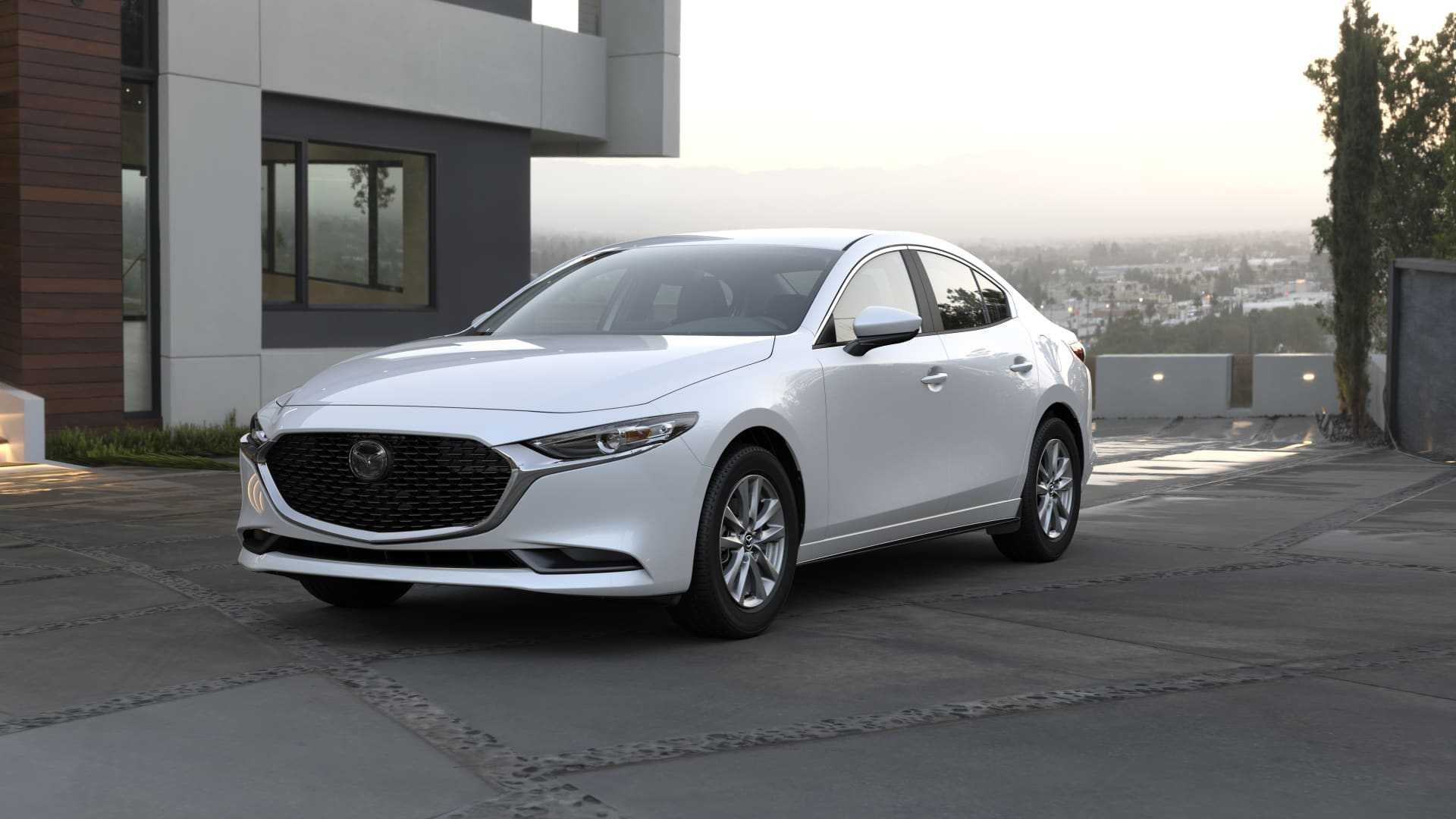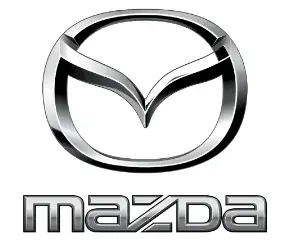Mazda 3 Sedan 2023 Brake System User Manual
Introduction
When it comes to vehicle safety, the brake system is without a doubt one of the most important components. The brake system in the Mazda 3 Sedan 2023 has been meticulously designed and engineered to provide enhanced stopping power, precise control, and overall safety. We will look at the features and benefits of the Mazda 3 Sedan 2023 brake system in this introduction.
Quick and Efficient Braking: The Mazda 3 Sedan 2023 has a responsive brake system that ensures quick and efficient braking performance. The brake system is designed to provide precise control and responsiveness, giving you confidence on the road, whether you need to slow down gradually or make an emergency stop.
Anti-lock Braking System (ABS): The Mazda 3 Sedan 2023 has an ABS that prevents the wheels from locking up during hard braking or in slippery road conditions. ABS allows you to keep steering control while braking, lowering your chances of skidding or losing control .Electronic Brakeforce Distribution (EBD): The Mazda 3 Sedan 2023’s Electronic Brakeforce Distribution (EBD) system optimizes braking force distribution to each wheel based on the vehicle’s load and dynamic conditions. This ensures balanced braking performance and stability, particularly when braking suddenly or transporting varying passenger and cargo loads.
Brake System
Foot Brake
This vehicle has power-assisted brakes that adjust automatically through normal use.
Should power-assist fail, you can stop by applying greater force than normal to the brake pedal. But the distance required to stop will be greater than usual.
WARNING
Do not coast with the engine stalled or turned off, find a safe place to stop: Coasting with the engine stalled or turned off is dangerous. Braking will require more effort, and the brake’s power-assist could be depleted if you pump the brake. This will cause longer stopping distances or even an accident.
Shift to a lower gear when going down steep hills:
Driving with your foot continuously on the brake pedal or steadily applying the brakes for long distances is dangerous. This causes overheated brakes, resulting in longer stopping distances or even total brake failure. This could cause loss of vehicle control and a serious accident. Avoid continuous application of the brakes.
Dry off brakes that have become wet by driving slowly, releasing the accelerator pedal and lightly applying the brakes several times until the brake performance returns to normal: Driving with wet brakes is dangerous. Increased stopping distance or the vehicle pulling to one side when braking could result in a serious accident. Light braking will indicate whether the brakes have been affected.
CAUTION
- Do not drive with your foot held on the clutch pedal or brake pedal, or hold the clutch pedal depressed halfway unnecessarily. Doing so could result in the following:
The clutch and brake parts will wear out more quickly.
The brakes can overheat and adversely affect brake performance.
Always depress the brake pedal with the right foot. Applying the brakes with the unaccustomed left foot could slow your reaction time to an emergency situation resulting in insufficient braking operation.
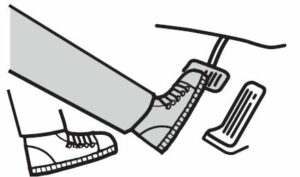
- Wear shoes appropriate for driving in order to avoid your shoe contacting the brake pedal when depressing the accelerator pedal.
Electric Parking Brake (EPB)
The EPB system applies the parking brake using an electric motor. The system can operate automatically and manually.
The EPB switch indicator light turns on when applying the parking brake and it turns off when releasing the parking brake.

- Indicator light
WARNING
Do not drive the vehicle with the parking brake applied:
If the vehicle is driven with the parking brake applied, the brake parts may generate heat and the brake system may not operate, leading to an accident.
Before driving the vehicle, release the parking brake and make sure that the EPB indicator light in the instrument cluster turns off.
Apply the parking brake when leaving the vehicle:
Not applying the parking brake when parking the vehicle is dangerous as the vehicle may move unexpectedly and result in an accident. Before leaving the vehicle, apply the parking brake and make sure that the EPB indicator light in the instrument cluster turns on.
NOTE
- The parking brake cannot be applied or released while the vehicle battery is dead.
Refer to If a Jump-Starting
When the charging system warning light in the instrument cluster turns on, the parking brake cannot be applied after switching the ignition OFF. Before switching the ignition OFF, apply the parking brake manually.
The sound of the parking brake being applied or released can be heard, however, this does not indicate a problem.
If the EPB is not used for long periods, an automatic inspection of the system is performed while the vehicle is parked. An operation sound can be heard, however, this does not indicate a problem.
When applying the parking brake and switching OFF the ignition, an operation sound can be heard, however, this does not indicate a problem.
The brake pedal may move while applying or releasing the parking brake, however, this does not indicate a problem.
If the parking brake is applied with the ignition switched OFF or in ACC, the EPB indicator light in the instrument cluster and the indicator light in the switch may turn on for 15 seconds.
When using an automatic car wash which moves the vehicle with the front tires mounted, it is necessary to cancel the parking brake auto operation before the vehicle enters the automatic car wash. For details, refer to Canceling the parking brake automatic operation.
Manual operation
Applying the parking brake manually
When the brake pedal is firmly depressed and the EPB switch is pulled up, the parking brake is applied regardless of the ignition position. When the parking brake is applied, the EPB indicator light in the instrument cluster and the EPB switch indicator light turn on.

- Releasing the parking brake manually
When the brake pedal is firmly depressed and the EPB switch is pressed while the ignition is switched ON or the engine is running, the parking brake is released. When the parking brake is released, the EPB indicator light in the instrument cluster and the EPB switch indicator light turn off. 
- If the EPB switch is pressed without depressing the brake pedal, a message is displayed on the multi-information display to notify the driver to depress the brake pedal.
Refer to Message Indicated on Multi-information Display - Auto operation
Applying the parking brake automatically
When the ignition is switched from ON to ACC or OFF, the parking brake will be applied automatically. When the parking brake is applied, the EPB indicator light in the instrument cluster and the EPB switch indicator light turn on. - NOTE
To release the parking brake when the ignition is switched OFF, it is necessary to cancel the parking brake auto operation. For details, refer to Canceling the parking brake automatic operation.
Releasing the parking brake automatically
(Shift interlock release (Automatic transmission vehicle))
CAUTION
Firmly depress the brake pedal and perform the shift operation. Otherwise, the vehicle may move unexpectedly.
If the selector lever is shifted from the P position to a position other than P with the parking brake applied and all of the following conditions met, the parking brake is released automatically. When the parking brake is released, the EPB indicator light in the instrument cluster and the EPB switch indicator light turn off.
- The engine is running.
The driver’s door is closed.
Shift interlock release is enabled.
The brake pedal is being depressed.
When performing the following operations, shift interlock release can be enabled/disabled.
- Switch the ignition ON.
- Pull the EPB switch continuously for 4 seconds or longer.
- Release the EPB switch once and then pull it again continuously for 4 seconds or longer within 3 seconds.(Switching from disable to enable shift interlock release)
When shift interlock release is enabled, a sound is activated 2 times and the EPB switch indicator changes to fast flashing, and flashes for 3 seconds.
(Switching from enable to disable shift interlock release)
When shift interlock release is disabled, a sound is activated 2 times and the EPB switch indicator light changes to slow flashing, and flashes for 4 seconds.
NOTE
When the ignition is switched OFF, the system setting before it was turned off is maintained.
(Accelerator interlock release)
If the accelerator pedal is depressed with the parking brake applied and all of the following conditions met, the parking brake is released automatically. When the parking brake is released, the EPB indicator light in the instrument cluster and the EPB switch indicator light turn off.
- The engine is running.
The driver’s door is closed.
The driver’s seat belt is fastened.
(Manual transmission vehicle) - The shift lever is in a position other than neutral.
The clutch pedal is depressed halfway.
(Automatic transmission vehicle)
The selector lever is in the D, M, or R position.
CAUTION
If something such as the driver’s foot contacts the accelerator pedal with the engine running and the parking brake applied, the parking brake may be released automatically and the vehicle may move unexpectedly. If you do not intend to start driving the vehicle immediately, shift the shift lever to the neutral position for a manual transmission, or shift the selector lever to the P or N position for an automatic transmission.
Canceling the parking brake automatic operation
The parking brake automatic operation can be canceled by doing any of the following after switching the ignition from ON to OFF.
Auto operation cancel method 1
- Switch the ignition ON.
- Release the parking brake manually.
- Turn off the AUTOHOLD.
- Press the EPB switch continuously for 2 seconds or longer (until a sound is activated).
- Release the EPB switch and switch the ignition OFF within 5 seconds after the sound was activated. After the auto operation is canceled, a sound is activated one time, and the EPB switch indicator light switches from illumination to flashing, and then turns off after 3 seconds.
Auto operation cancel method 2
- Switch the ignition ON.
- Release the parking brake manually.
- Turn off the AUTOHOLD.
- Switch the ignition OFF with the EPB switch pressed while the brake pedal is not depressed.
When the auto operation is canceled, a sound is activated one time, and the EPB switch indicator light goes from normal flashing to faster flashing, and then turns off after 3 seconds.
NOTE
- When canceling the parking brake auto operation and parking the vehicle, shift the shift lever to the 1st gear or the R position for a manual transmission, or shift the selector lever to the P position for an automatic transmission, and then use wheel blocks.
- The auto operation may not cancel if the vehicle is parked on a steep slope.
When the ignition is switched ON, the parking brake auto operation is restored.
How to use Emergency Brake
If there is a problem with the brake system (foot brake) while driving the vehicle or in an emergency situation where the driver cannot step on the brake pedal, continually pulling up the EPB switch will apply the brakes and decelerate or stop the vehicle. The parking brake on-reminder sound is activated while the brake is applied. In addition, when releasing the switch, the brake is released and the sound stops.
WARNING
Use Emergency Brake only in an emergency situation:
Excessive use may cause the brake parts to wear quickly or the brakes to heat up and become less effective.
Warning Light
The warning light turns on when the system has a malfunction.
Refer to Brake System Warning Indication/Warning Light
Brake Pad Wear Indicator
When the disc brake pads become worn, the built-in wear indicators contact the disc plates. This causes a screeching noise to warn that the pads should be replaced.
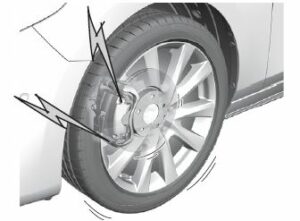
When you hear this noise, consult an Authorized Mazda Dealer as soon as possible.
WARNING
Do not drive with worn disc pads: Driving with worn disc pads is dangerous. The brakes could fail and cause a serious accident. As soon as you hear a screeching noise consult an Authorized Mazda Dealer.
NOTE
In high humidity weather conditions, brake noises, such as brake squeak or brake squeal can be heard. It does not indicate a malfunction.
Brake Assist
During emergency braking situations when it is necessary to depress the brake pedal with greater force, the brake assist system provides braking assistance, thus enhancing braking performance.
When the brake pedal is depressed hard or depressed more quickly, the brakes apply more firmly.
NOTE
- When the brake pedal is depressed hard or depressed more quickly, the pedal will feel softer but the brakes will apply more firmly. This is a normal effect of the brake assist operation and does not indicate a malfunction.
When the brake pedal is depressed hard or depressed more quickly, a motor/pump operation noise may be heard. This is a normal effect of the brake assist and does not indicate a malfunction.
The brake assist equipment does not supersede the functionality of the vehicle’s main braking system.
Brake Override System
The brake override system applies the brake first for safety if the brake pedal and accelerator pedal are depressed at the same time.
NOTE
Operation of the brake override system can be turned on or off.
Refer to the Settings section in the Mazda Connect Owner’s Manual.
AUTOHOLD
AUTOHOLD
The AUTOHOLD function automatically holds the vehicle stopped, even if you take your foot off the brake pedal. This function can be best used while stopped in traffic or at a traffic light. The brakes are released when you start driving the vehicle.
WARNING
Do not rely completely on the AUTOHOLD function:
The AUTOHOLD function is only designed to assist the brake operation while the vehicle is stopped. Neglecting to operate the brakes and relying only on the AUTOHOLD system is dangerous and could result in an unexpected accident if the vehicle were to suddenly move. Operate the brakes appropriately in accordance with the road and surrounding conditions.
Note that the vehicle may move suddenly depending on the vehicle’s load or if it is towing something.
Do not release your foot from the brake pedal while the vehicle is stopped on a steep grade:
Because there is a possibility of the vehicle not being held in the stopped position by the AUTOHOLD function, the vehicle may move unexpectedly and result in an accident.
Do not use the AUTOHOLD function on slippery roads such as icy or snow-covered roads, or unpaved roads:
Even if the vehicle is held in the stopped position by the AUTOHOLD function, the vehicle may move unexpectedly and result in an accident. Operate the accelerator pedal, brakes, or steering wheel appropriately as necessary.
Immediately depress the brake pedal in the following cases:
Because the AUTOHOLD function is canceled forcibly, the vehicle may move unexpectedly and result in an accident.
- “Depress Brake Pedal. Brake Hold Disabled” is displayed in the multi-information display and the warning sound is activated at the same time.
Always apply the parking brake when parking the vehicle:
Not applying the parking brake when parking the vehicle is dangerous as the vehicle may move unexpectedly and result in an accident. When parking the vehicle, shift the selector lever to the P position (automatic transmission vehicle) and apply the parking brake.
CAUTION
If you stop operating the accelerator pedal before the vehicle starts moving, the force holding the vehicle in the stopped position may weaken. Firmly depress the brake pedal or depress the accelerator pedal to accelerate the vehicle.
NOTE
Under the following conditions, a problem with the AUTOHOLD is occurring. Have your vehicle inspected at an Authorized Mazda Dealer as soon as possible.
A message is indicated on the multi-information display and a warning sound is activated for about 5 seconds while the AUTOHOLD is operating or when you press the AUTOHOLD switch.
If you switch the ignition OFF while the AUTOHOLD is operating, the parking brake is applied automatically to assist you with parking the vehicle.
The AUTOHOLD is canceled when the selector lever/shift lever is shifted to R position while the vehicle is on level ground, or facing up a hill or grade (as shown below).
|
Vehicle posture and road surface gradient |
AUTOHOLD operation status |
|
| Vehicle tilts forward |  |
Operates |
| Level ground | 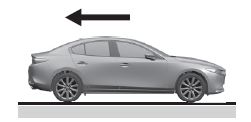 |
Does not operate, canceled |
| Vehicle tilts rearward | 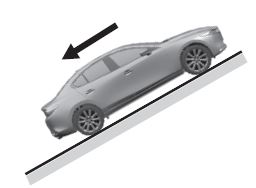 |
Does not operate, canceled |
- The brake pedal response may change, sound may occur from the brakes, or the brake pedal could vibrate from the operation of the AUTOHOLD function. However, this does not indicate a malfunction.
To Turn On AUTOHOLD System
Press the AUTOHOLD switch and when the AUTOHOLD standby indicator light turns on, the AUTOHOLD function turns on.
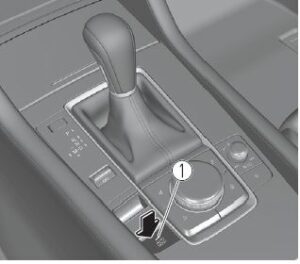
AUTOHOLD standby indicator light
NOTE
When all of the following conditions are met, the AUTOHOLD standby indicator light turns on when the AUTOHOLD switch is pressed and the AUTOHOLD function turns on.
- The ignition is switched ON (engine is running or stopped by i-stop).
The driver’s seat belt is fastened.
The driver’s door is closed.
There is no problem with the AUTOHOLD function.
To operate AUTOHOLD and hold the brakes
- Depress the brake pedal and bring the vehicle to a complete stop.
- The AUTOHOLD active indicator light in the instrument cluster turns on and the brakes are held.

- The vehicle is held in its stopped position even with the brake pedal released.
NOTE
When all of the following conditions are met, the AUTOHOLD operates and the brakes are held.
- The ignition is switched ON (engine is running or stopped by i-stop).
The vehicle is stopped.
The brake pedal is being depressed.
The AUTOHOLD active indicator light turns on.
The accelerator pedal is not depressed.
The driver’s seat belt is fastened.
The driver’s door is closed.
There is no problem with the AUTOHOLD function.
The parking brake is released.
There is no problem with the Electric Parking Brake (EPB) function.
(Automatic transmission vehicle) The selector lever is in a position other than R position or the vehicle tilts forward with the selector lever in the R position.
To release AUTOHOLD and start driving the vehicle
If you try to resume driving the vehicle, the brakes will be released automatically and the AUTOHOLD active indicator light turns off.
NOTE
- If the Electric Parking Brake (EPB) switch is pulled while the AUTOHOLD is operating, the parking brake is applied and the AUTOHOLD is released. In addition, if the parking brake is released under this condition, the AUTOHOLD operates to hold the brakes.
Under the following conditions, the parking brake is automatically applied and the AUTOHOLD is released. The AUTOHOLD is re-enabled when the conditions before the AUTOHOLD is released are restored.
The driver’s seat belt is unfastened.
The driver’s door is opened.
When about 10 minutes or longer have passed since the AUTOHOLD operation started, the parking brake is automatically applied. Because the AUTOHOLD is restored when releasing the parking brake, the hold on the brakes by AUTOHOLD function resumes.
- (Manual transmission vehicle)
When starting to drive the vehicle forward or in reverse on a down slope, depress the clutch pedal and shift the shift lever to the appropriate position for driving in the desired direction, and then depress the accelerator pedal to release the AUTOHOLD.
The AUTOHOLD can be canceled forcibly by fully depressing the accelerator pedal for 1 second or longer while the AUTOHOLD is operating. Forcibly cancel the AUTOHOLD only when the AUTOHOLD cannot be canceled due to a system malfunction or it is necessary to cancel the AUTOHOLD in an emergency.
To Turn Off AUTOHOLD System
Depress the brake pedal and press the AUTOHOLD switch. The AUTOHOLD is turned off and the AUTOHOLD standby indicator light turns off.
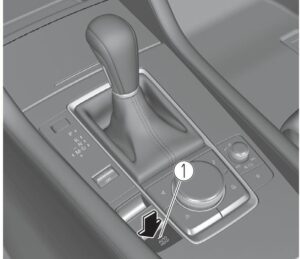
- AUTOHOLD standby indicator light
NOTE
- When the brakes are not held such as while driving the vehicle, the AUTOHOLD can be turned off only by pressing the AUTOHOLD switch.
If the AUTOHOLD switch is pressed without depressing the brake pedal while AUTOHOLD is operating
(AUTOHOLD active indicator light in instrument cluster is turned on), the message “Depress Brake Pedal and Operate Switch to Release” is indicated on the multi-information display to notify the driver to depress the brake pedal.. - If any of the following conditions occurs while the AUTOHOLD function is operating (AUTOHOLD active indicator light is turned on), the parking brake is applied automatically and the AUTOHOLD function turns off. For the Electric Parking Brake (EPB) operation, refer to the Electric Parking Brake (EPB) on The ignition is switched OFF.
There is a problem with the AUTOHOLD function.
Hill Launch Assist (HLA)
Hill Launch Assist (HLA)
The HLA functions to assist in accelerating the vehicle from a stop on slopes. When releasing the brake pedal and depressing the accelerator pedal to accelerate the vehicle from a stop while on a slope, the function prevents the vehicle from rolling. The HLA also operates when reversing on a slope. The braking force is maintained automatically after releasing the brake pedal on a steep slope.
For manual transmission vehicles, the HLA operates when the vehicle is tilted rearward with the shift lever in a forward gear, and operates when the vehicle is tilted forward with the shift lever in the R position.
For automatic transmission vehicles, the HLA operates when the vehicle is tilted rearward with the selector lever in a forward gear, and operates when the vehicle is tilted forward with the selector lever in the R position.
WARNING
Do not rely completely on HLA:
HLA is an auxiliary device for accelerating from a stop on a slope. The system only operates for about 2 seconds and therefore, relying only on the system, when accelerating from a stop is dangerous because the vehicle may move (roll) unexpectedly and cause an accident.
The vehicle could roll depending on the vehicle’s load or if it is towing something. In addition, for vehicles with a manual transmission, the vehicle could still roll depending on how the clutch pedal or the accelerator pedal is operated.
Always confirm the safety around the vehicle before starting to drive the vehicle.
NOTE
- HLA does not operate on a gentle slope. In addition, the gradient of the slope on which the system will operate changes depending on the vehicle’s load.
HLA does not operate if the parking brake is applied, the vehicle has not stopped completely, or the clutch pedal is released.
While HLA is operating, the brake pedal may feel stiff and vibrate, however, this does not indicate a malfunction.
HLA does not operate while the TCS/DSC indicator light is illuminated.
Refer to TCS/DSC Indication/Indicator Light (Turns on)
HLA does not turn off even if the DSC OFF switch is pressed to turn off the TCS/DSC.
Antilock Brake System (ABS)
Antilock Brake System (ABS)
The ABS control unit continuously monitors the speed of each wheel. If one wheel is about to lock up, the ABS responds by automatically releasing and reapplying that wheel’s brake. The driver will feel a slight vibration in the brake pedal and may hear a chattering noise from the brake system. This is normal ABS system operation. Continue to depress the brake pedal without pumping the brakes.
The warning light turns on when the system has a malfunction.
Refer to ABS Warning Indication/Warning Light
WARNING
Do not rely on ABS as a substitute for safe driving:
The ABS cannot compensate for unsafe and reckless driving, excessive speed, tailgating (following another vehicle too closely), driving on ice and snow, and hydroplaning (reduced tire friction and road contact because of water on the road surface). You can still have an accident.
NOTE
- Braking distances may be longer on loose surfaces (snow or gravel, for example) which usually have a hard foundation. A vehicle with a normal braking system may require less distance to stop under these conditions because the tires will build up a wedge of surface layer when the wheels skid.
- The sound of the ABS operating may be heard when starting the engine or immediately after starting the vehicle, however, it does not indicate a malfunction.
Traction Control System (TCS)
Traction Control System (TCS)
The Traction Control System (TCS) enhances traction and safety by controlling engine torque and braking. When the TCS detects driving wheel slippage, it lowers engine torque and operates the brakes to prevent loss of traction.
This means that on a slick surface, the engine adjusts automatically to provide optimum power to the drive wheels, limiting wheel spin and loss of traction.
The warning light turns on when the system has a malfunction.
Refer to TCS/DSC Indication/Indicator Light (Turns on)
WARNING
Do not rely on the Traction Control System (TCS) as a substitute for safe driving:
The Traction Control System (TCS) cannot compensate for unsafe and reckless driving, excessive speed, tailgating (following another vehicle too closely), and hydroplaning(reduced tire friction and road contact because of water on the road surface). You can still have an accident.
Use snow tires or tire chains and drive at reduced speeds when roads are covered with ice and/or snow: Driving without proper traction devices on snow and/or ice-covered roads is dangerous. The Traction Control System (TCS) alone cannot provide adequate traction and you could still have an accident.
NOTE
To turn off the TCS, press the DSC OFF switch
TCS/DSC Indicator Light

This indicator light stays on for a few seconds when the ignition is switched ON.
If the TCS or DSC is operating, the indicator light flashes.
If the light stays on, the TCS, DSC or the brake assist system may have a malfunction and they may not operate correctly. Take your vehicle to an Authorized Mazda Dealer.
NOTE
- In addition to the indicator light flashing, a slight lugging sound will come from the engine. This indicates that the TCS/DSC is operating properly.
On slippery surfaces, such as fresh snow, it will be impossible to achieve high rpm when the TCS is on.
Dynamic Stability Control (DSC)
Dynamic Stability Control (DSC)
The Dynamic Stability Control (DSC) automatically controls braking and engine torque in conjunction with systems such as ABS and TCS to help control side slip when driving on slippery surfaces, or during sudden or evasive maneuvering, enhancing vehicle safety.
Refer to ABS and TCS
DSC operation is possible at speeds greater than 20 km/h (12 mph).
The warning light turns on when the system has a malfunction.
Refer to TC
S/DSC Indication/Indicator Light (Turns on)
WARNING
Do not rely on the Dynamic Stability Control as a substitute for safe driving:
The Dynamic Stability Control (DSC) cannot compensate for unsafe and reckless driving, excessive speed, tailgating (following another vehicle too closely), and hydroplaning (reduced tire friction and road contact because of water on the road surface). You can still have an accident.
CAUTION
- The DSC may not operate correctly unless the following are observed:
Use tires of the correct size specified for your Mazda on all 4 wheels.
Use tires of the same manufacturer, brand and tread pattern on all 4 wheels.
Do not mix worn tires.
The DSC may not operate correctly when tire chains are used or a temporary spare tire is installed because the tire diameter changes.
NOTE
If there is a problem with the DSC, the Hill Launch Assist (HLA) may not operate.
Refer to Hill Launch Assist (HLA)
TCS/DSC Indicator Light

This indicator light stays on for a few seconds when the ignition is switched ON. If the TCS or DSC is operating, the indicator light flashes.
If the light stays on, the TCS, DSC or the brake assist system may have a malfunction and they may not operate correctly. Take your vehicle to an Authorized Mazda Dealer.
DSC OFF Indicator Light

This indicator light stays on for a few seconds when the ignition is switched ON.
It also illuminates when the DSC OFF switch is pressed and TCS/DSC is switched off.
Refer to DSC OFF Switch
If the light remains illuminated and the TCS/DSC is not switched off, take your vehicle to an Authorized Mazda Dealer. The DSC may have a malfunction.
DSC OFF Switch
Press the DSC OFF switch to turn off the TCS/DSC. The DSC OFF indicator light in the instrument cluster will illuminate.
Press the switch again to turn the TCS/DSC back on. The DSC OFF indicator light will turn off.
NOTE
- When the TCS/DSC is on and you attempt to free the vehicle from being stuck, the TCS/DSC will activate. Depressing the accelerator will not increase engine power and freeing the vehicle from being stuck might be difficult. When this happens, turn off the TCS/DSC.
If the TCS/DSC is off when the engine is turned off, it automatically activates when the ignition is switched ON.
Leaving the TCS/DSC on will provide the best traction.
If the DSC OFF switch is pressed and held for 10 seconds or more, the DSC OFF switch malfunction detection function operates and the TCS/DSC system activates automatically. The DSC OFF indicator light turns off while the TCS/DSC system is operative.
(Vehicles with Smart Brake Support (SBS))
If the Smart Brake Support (SBS) operates with the TCS/DSC turned off, the TCS/DSC becomes operational automatically.
Operation of the brake override system can be turned on or off.
Refer to the Settings section in the Mazda Connect Owner’s Manual.
Drive Selection
- Drive Selection
Drive selection is a system to switch the vehicle’s drive mode. When the sport mode is selected, vehicle’s response against accelerator operation is enhanced. This provides additional quick acceleration which may be needed to safely make maneuvers such as lane changes, merging onto freeways, or passing other vehicles.
CAUTION
Do not use the sport mode when driving on slippery roads such as wet or snow-covered roads. It may cause tire slipping.
NOTE
- When the sport mode is selected, driving at higher engine speeds increases and it may increase fuel consumption. Mazda recommends that you cancel the sport mode on normal driving.
Drive mode cannot be switched in the following conditions:
ABS/TCS/DSC is operating
Cruise control* is operating.
The Mazda Radar Cruise Control (MRCC) system* is operating.
The Mazda Radar Cruise Control with Stop & Go function (MRCC with Stop & Go function) System* is operating.
Traffic Jam Assist (TJA) is operating.
Steering wheel is being operated abruptly
Drive Selection Switch
Press the drive selection switch forward (SPORT) to select the sport mode. Pull the drive selection switch back
(OFF) to cancel the sport mode.

NOTE
- In the following cases, the drive selection is canceled.
The ignition is switched OFF.
Mazda Radar Cruise Control with Stop & Go function (MRCC with Stop & Go function) System/cruise control is set.
Traffic Jam Assist (TJA) is set.
Depending on the driving conditions when sport mode is selected, the vehicle may perform shift-down or slightly accelerate.
Select Mode Indicator Light
When the sport mode is selected, the select mode indicator light turns on in the instrument cluster.

Select mode indicator light
NOTE
If the drive selection cannot be switched to sport mode, the select mode indicator light flashes to notify the driver.
FAQs
The Mazda 3 Sedan 2023 has a hydraulic braking system.
Yes, the Mazda 3 Sedan 2023 comes standard with an anti-lock braking system (ABS).
The Mazda 3 Sedan 2023 does have a brake assist system, which provides extra braking force in emergency situations.
Depending on the trim and configuration of the Mazda 3 Sedan 2023, the brake rotor size may vary. For accurate information, refer to the vehicle’s specifications or consult with a Mazda dealer.
The Mazda 3 Sedan 2023’s front brakes are typically ventilated, while the rear brakes can be solid or ventilated depending on trim level.
The Mazda 3 Sedan 2023 lacks regenerative braking. It is reliant on conventional hydraulic braking systems.
Yes, the Mazda 3 Sedan 2023 has advanced safety features like Smart City Brake Support (SCBS) and Smart Brake Support (SBS), which can help mitigate or prevent collisions by automatically applying the brakes in certain situations.
The Mazda 3 Sedan’s braking system is not user-adjustable. It is, however, intended to provide a balanced and responsive braking performance.
Yes, the Mazda 3 Sedan 2023 has a brake override system, which ensures that pressing the brake pedal takes precedence over pressing the accelerator pedal.
For optimal brake system performance, regular maintenance, including brake pad inspections, brake fluid checks, and rotor inspections, is recommended. It is recommended that you adhere to the maintenance schedule outlined in your vehicle’s owner’s manual.
While aftermarket brake pads are available, genuine Mazda brake pads or those recommended by Mazda are preferred for proper fit and performance.
Brake pad lifespan varies depending on driving conditions, driving style, and other factors. It is recommended that the brake pads be inspected on a regular basis and replaced as needed.
The Mazda 3 Sedan 2023 does have a brake pedal position sensor that detects the position and movement of the brake pedal.
The Mazda 3 Sedan 2023 is usually equipped with a brake fluid level warning system that alerts the driver when the brake fluid level is low.
The Mazda 3 Sedan is not intended for heavy towing. For information on towing capacity and any specific brake system considerations, consult the vehicle’s specifications or contact a Mazda dealer.
Useful Links
View Full User Guide: 2023 Mazda 3 Sedan User Manual | Auto User Guide
Download Link: Owner’s – Manuals, Guides, Maintenance Schedules | Mazda USA

